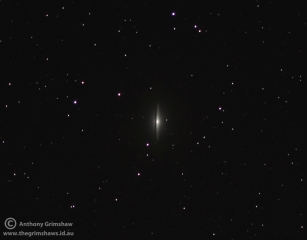The Sombrero Galaxy (M104)
Another image I managed to take at the BAS weekend club event was the Sombrero Galaxy. This image was taken on Saturday 20th May 2012, at around midnight at Hazeldean QLD, Australia. The seeing conditions were about an 8.5 /10. I used my Canon EOS 600D DSLR to take the image and the exposure times were as follows:
- 300 Seconds at ISO 400 * 5 Frames
- 300 Seconds at ISO 800 * 2 Frame
For processing the image I used Deep Sky Stacker, I didn’t use any Darks, Flats or Bias frames in the stacking process, after the images were stacked I adjusted the levels slightly and created cropped view (it’s a bit small in my 90mm F6.3 scope), saved it and uploaded for viewing.
A little more info about the Galaxy you can see in the image:
- Name: M104
- Type: Elliptical Galaxy (so it is thought at this stage)
- Magnitude: 8.9
- Constellation: Virgo
- Distance: 29 Million Light Years
- Other Designations: Messier 104, NGC 4594, PGC 42407
M104 or better known as the Sombrero Galaxy is an Elliptical Galaxy in the constellation Virgo, It is estimated to be approximately 28 million light years from Earth. It has a bright nucleus, an unusually large central bulge, and a prominent dust lane surrounding its bright core. The dark dust lane and the central bulge give this galaxy the appearance of a sombrero hence its name.
It was initially thought that the Sombrero was a spiral galaxy. But deep spacing imaging with modern equipment has since shown this is more likely a giant elliptical galaxy. The galaxy has an apparent magnitude of ~+9.0, making it easily visible with amateur telescopes. The large bulge and dark dust lane attracts the attentions of astronomers amateur and professional alike. It really is a spectacular site.
The Sombrero Galaxy was discovered by Pierre Méchain in March 1767, however Charles Messier made a hand-written note about this and five other objects (now collectively recognized as M104 – M109) to his personal list of objects now known as the Messier Catalogue, but it was not “officially” included until 1921. William Herschel also independently discovered the object in 1784 and noted the presence of a “dark stratum” in the galaxy’s disc, that is now called a dust lane.
I hope you enjoy my image 🙂
Cheers
Anthony
